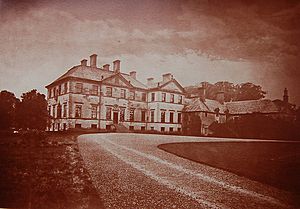Charles Hope-Weir facts for kids
Charles Hope-Weir (born May 8, 1710 – died December 30, 1791) was an important Scottish politician. He was known for his love of travel and for improving his family estate.
Contents
Early Life and Family Name
Charles Hope-Weir was born Charles Hope. His father was Charles Hope, 1st Earl of Hopetoun. In 1730, Charles inherited the large Craigiehall estate in Scotland from his uncle.
When he married Catherine Weir in 1733, he changed his name to Hope-Weir. This was a way to honor his wife's family, the Weirs of Blackwood. Later, the family name was changed again to Hope-Vere.
A Career in Politics
Charles Hope-Weir became a Member of Parliament (MP) in 1743. An MP is a person elected to represent a certain area in the country's government. He represented the area of Linlithgowshire until 1769.
He also held other important jobs. In 1744, he became the Governor of Blackness Castle, a historic fortress. He was also the Commissary General of the Musters in Scotland, which meant he helped manage the army's records. Another role was Ranger of Ettrick Forest, looking after a large forest area.
The Grand Tour
In 1754, Charles Hope-Weir went on a "Grand Tour" of Italy. This was a long trip that many young, wealthy men took in those days. It was a way to learn about art, history, and culture in Europe. His uncle and brother encouraged him to go.
He traveled with a young architect named Robert Adam. They met in Brussels and journeyed through France and Italy, visiting cities like Lyon, Marseilles, Nice, and Genoa. They arrived in Rome in February 1755. However, Charles and Robert had a disagreement about travel costs and a house they both wanted to rent. Even though they remained polite, they didn't get along well after that.
After Easter, Charles continued his trip to Naples. He returned home in late 1755 with his son, traveling through Frankfurt because of political issues in France. He arrived back in Britain in May 1756.
Improving Craigiehall Estate
When he returned home, Charles Hope-Weir began to improve his estate at Craigiehall. He worked with the famous Adam Brothers, who were architects. They designed a grotto (a small cave-like structure), a bridge, and a temple for his estate.
The bridge has his initials and the year 1757 carved into it. It also has a Latin quote from the writer Horace: UTILI DULCI. This means "the useful with the sweet." Sadly, the bath house is now in ruins. The temple, located on Lennie Hill, was made smaller in the 1970s because it was too close to Edinburgh Airport.
Family Life
Charles Hope-Weir was married three times and had many children. His family included several notable people who went on to have important careers.
- His first wife was Catherine Weir. They had three children, including:
* William Hope-Weir (1736–1811), who also became an MP. * John Hope (1739–1785), whose sons became a judge, a general, and a vice-admiral.
- His second wife was Lady Anne Vane. They had two sons:
* Captain Charles Hope (died 1808), who served in the Royal Navy. * Brigadier-General Henry Hope (died 1789), who became the Deputy Governor General of Canada.
- His third wife was Helen Dunbar. They had four children, including:
* Admiral Sir George Johnstone Hope (1767–1818), who was a naval officer. * Helen Charlotte Hope, who married John Knight, a pioneer who worked to improve the land on Exmoor. * Elizabeth Vere Hope (died 1801), who married John Hope, 4th Earl of Hopetoun.


